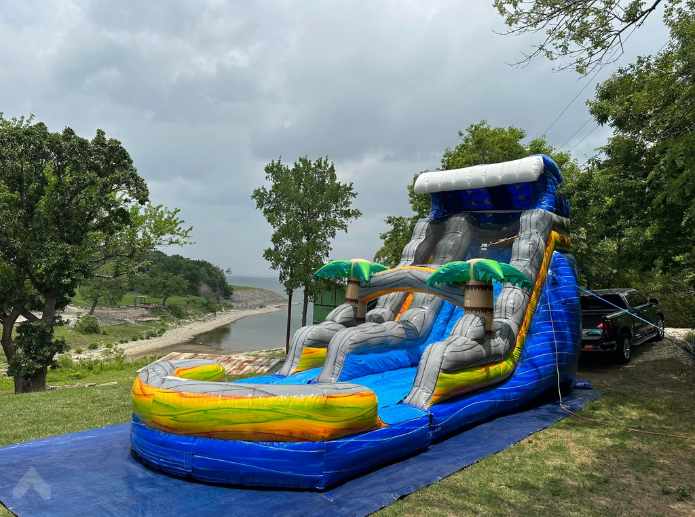866-296-3868
866-296-3868

How to Properly Secure an Inflatable Bounce House, Water Slide, or Obstacle Course on Grass and Concrete
Inflatable attractions like bounce houses, water slides, and obstacle courses are a staple at birthday parties, school carnivals, and summer events. They provide hours of fun for kids and even adults. But with that fun comes responsibility. Properly securing these inflatables is essential to ensure safety and avoid injuries caused by wind gusts, tipping, or shifting during use. Here’s a comprehensive guide on how to properly secure inflatables on both grass and concrete surfaces.
Before diving into the how-to, it’s important to understand the why. A sudden wind gust can lift an unsecured inflatable, potentially causing serious injuries. According to the Consumer Product Safety Commission (CPSC), dozens of children are injured every year due to improperly anchored inflatables. Proper anchoring keeps the inflatable stable, prevents tipping, and ensures a safe experience for everyone.
Grass is one of the most common and safest surfaces for inflatable set-ups. The soil offers natural flexibility and allows for deep anchoring.
1. Use Heavy-Duty Stakes
Type: Use steel stakes, typically 18" to 30" in length and at least 5/8" thick.
Angle: Insert the stakes at a 45-degree angle away from the inflatable for maximum resistance.
Depth: Drive the stakes fully into the ground so that only a small loop remains visible for tying.
2. Anchor All Points
Inflatables come with anchor points—usually at each corner and sometimes along the sides. Use every provided anchor point. Do not skip any, even if the inflatable seems secure.
3. Add Sandbags for Extra Stability
While stakes are generally sufficient, adding sandbags or weight bags at the base can provide an additional layer of safety, especially in windy areas.
4. Check Ground Conditions
Avoid areas with overly wet or soft soil, as stakes can loosen. If rain is expected, inspect your anchors frequently and add extra weight as needed.
Concrete, asphalt, or gym floors require a different approach since stakes cannot be used. Special equipment and extra precautions are necessary.
1. Use Weight Anchors
Sandbags: Use heavy-duty sandbags (minimum 40 lbs per anchor point) made specifically for inflatables.
Water Barrels: In commercial settings, 55-gallon water barrels can be used, secured with ratchet straps to anchor points.
Concrete Weights: Rubber-coated or strapped concrete blocks are another reliable option.
2. Secure with Ratchet Straps or Bungee Cords
Tie each anchor point to the weights using ratchet straps. Avoid ropes or light cords, as they can loosen or snap under tension.
3. Use Non-Slip Mats or Tarps
Place a non-slip tarp or mat under the inflatable to prevent sliding on smooth surfaces. This also protects the bottom of the inflatable from friction damage.
4. Block Off Windy Areas
Concrete setups are often outdoors where wind exposure is higher. Use temporary fencing, walls, or vehicles as windbreaks if possible. Always monitor wind speeds, and never operate in winds exceeding 15-20 mph.
Check Local Codes: Some municipalities have rules or permits required for inflatable setup, particularly on public property.
Perform Regular Checks: Re-check all anchor points every few hours or after heavy use.
Supervision is Mandatory: Always have an adult supervising the inflatable to monitor activity and ensure rules are followed.
Weather Awareness: Immediately deflate and stop use during high winds, rain, or electrical storms.
Securing your inflatable bounce house, water slide, or obstacle course is not just a safety step—it’s a responsibility. Whether you’re setting up in your backyard or hosting a community event, taking the time to properly anchor your inflatable can prevent injuries and equipment damage. Use the right tools for the right surface—stakes for grass and weights for concrete—and always follow manufacturer guidelines.
Remember, fun should never come at the cost of safety. With these steps, you can ensure your inflatable setup stays firmly grounded, no matter where you put it.
{"one"=>"Select 2 or 3 items to compare", "other"=>"{{ count }} of 3 items selected"}